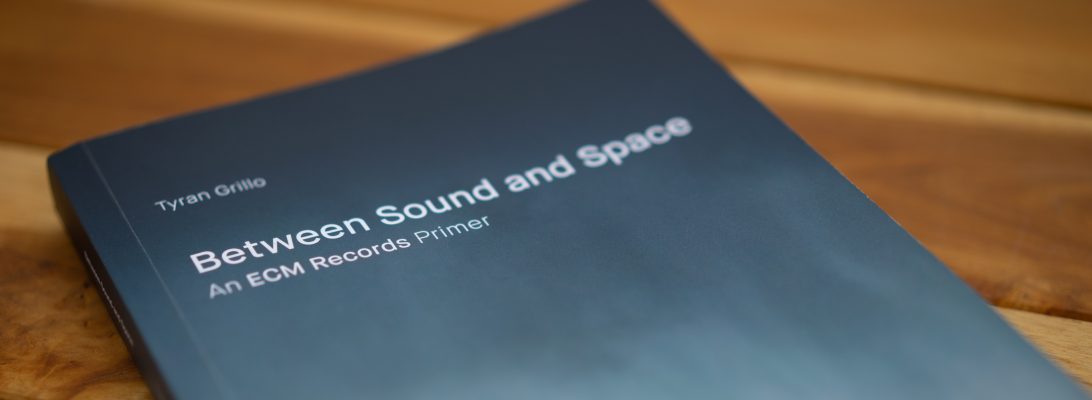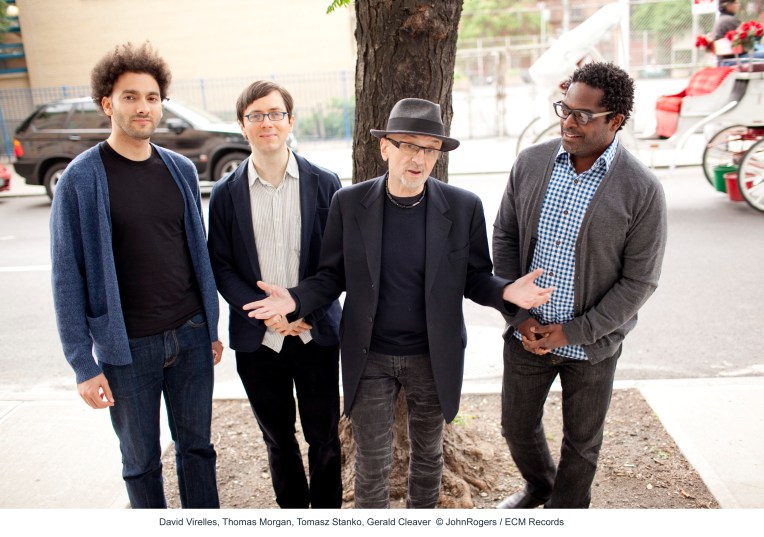Tomasz Stanko New York Quartet
Wisława
Tomasz Stanko trumpet
David Virelles piano
Thomas Morgan bass
Gerald Cleaver drums
Recorded June 2012 at Avatar Studios, New York
Engineer: James A. Farber
Assistant: Charlie Kramsky
Produced by Manfred Eicher
They call it: space.
It’s easy to define with that one word,
much harder with many.
The verse comes from the poem “Before a Journey” by Nobel Laureate Wisława Szymborska, whose legacy gives color to a starry tribute from trumpeter Tomasz Stanko. Given the snapshot ethics of Szymborska’s visual language, one could find no better musical interpreter to put this epigraph to the test. For though words may indeed fall short of expressing these swaths of infinitude we call “albums,” the language of instruments in the right hands can accomplish the impossible.

Wisława Szymborska (1923-2012)
One need hardly expound the virtues of Stanko’s new allies, each handpicked from the profuse garden of the New York City jazz scene. Pianist David Virelles brings a robust gentility to the table that meshes effortlessly with Stanko’s own. Bassist Thomas Morgan and drummer Gerald Cleaver—rhythm section to Craig Taborn’s trio—offer their dark synergy in kind. The proof, as they say, is in the pudding, and over the thickly whipped concoction of this 2-disc set it reaches our ears at the peak of flavor and consistency.
True to inspiration, Stanko and company derive wry upsweep from sentiments that, while unspoken, nevertheless dance in the spaces between. Of those spaces we encounter many, though of a markedly different cast from Stanko’s past ECM joints with the Polish quartet. Those expecting the aching, cool moroseness of that past may marvel at the prevalence of fire. The band swings with the best of them in “Tutaj – Here,” a track that takes its name, like a handful of others, from Szymborska’s final collection. Stanko leaps, as he does also in “Assassins,” at the fortuitousness of this meeting of word, feeling, and expression. He makes us aware of the here and now, as if we were there in the studio with him. Yet while the band is busy running all sorts of virtuosic errands in these dizzying soundscapes, we know that the finery is as thick as the souls it clothes.
The restless grooves of “Metafizyka” and “Mikrokosmos” find the band in a more down-tempo mood, though no less beguiling for melodic accuracy and Stanko’s unchained asides. Further allusions refract in “Faces” and “A Shaggy Vandal,” both highlights, taking their cue from Symborska’s poem “Thoughts That Visit Me on Busy Streets.” Stanko is at the top of his lyrical game in the former, trading off artfully with the others in cells of interpretation, to which Cleaver adds a vivid soliloquy of his own, while the latter is a well-oiled machine that blends influences into a postmodern mélange of rhythmic beastliness.
Despite these dips into upbeat waters, creature comforts reveal a heart whose petals have only grown fuller with the blush of time. Still, lurking in the album’s tenderest moments is an emotional heaviness. This is apparent in the fine patchworks of surplus and deficit that are “Dernier Cri,” in which the ghost of Miles is felt tenfold, and the wistful, floating “Song For H.” For another, “Oni” summons with smooth ritual, showing restraint while inviting us all the same with its beguiling atmosphere: the hallmarks of any good Stanko tune. Though its charm may be as deceptive as its title (if indeed the Japanese meaning of “demon” is intended), we are better equipped for it to wander into “April Story,” which opens nostalgia like a love letter forgotten in the back of a sock drawer. It is a raindrop forever hanging at a leaf’s trembling tip, a tear that never falls but which is sucked back into the eye, whereupon it tells the others: Not today.
The title track and its 13-minute variation hug the set with dreams made real. Here the microscopy of the band is at full magnification. Stanko is the stain beneath Cleaver’s brushed cover slide, while Morgan and Virelles provide light and adjust the focus. Morgan’s especially contemplative soloing leaves us suspended before the blade of Stanko’s brass snips that thread and lets us drop into the quiet waters below. Notes linger, bringing us back to wistful ambiences of long ago.
Stanko wields his pen as surely as ever. His younger partners bring all the maturity needed to relay his torch with a grasp that lets everything slip through but the finest crystal. Tuneful to the core, each solo is a holistic admixture of heritages on the one hand and on the other elicits the satisfying crack of new eggs onto the frying pan. Do not go into this album expecting the lofty spaces of Lontano or Suspended Night. These songs are cruder oil to those past efforts’ refined, and all the more enchanting for it. Here the levels are grounded, not airborne. Denser and tenser is the name of the game. But let us not fall deeper into the trap of comparison, for Wisława possesses its own stage and protagonists. In this play there are no villains, only messengers of progress whose abilities precede them and whose reputations burgeon in golden light. Verily, verily so.
Promo video:
(To hear more samples of Wisława, click here.)




Tyran,
Thanks for explaining all this to a newbie in Jazz. We have met at the concert of the Stanko Quartet at the Birdland Jazz club on March 29th. I really enjoyed the show but didn’t know there is so much more behind the music on the surface.
As I am a blogger myself I appreciate the quality of you work: pictures and writing.
Kind regards,
Stefan Ferber
Thank you so much for checking out my writing, Stefan. It was great to meet you at the concert, of which I will have a review up soon, so stay tuned.
Reblogueó esto en {in.tegridad}y comentado:
Tomasz captures the spirit of Miles, Charlie and Duke along with the Jazz Heartbeat of NYC.